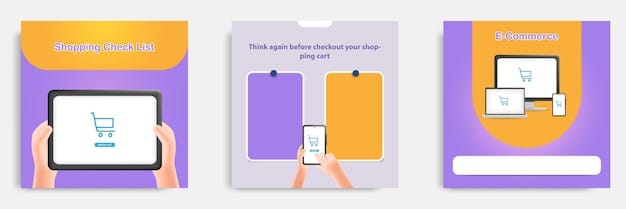E-commerce Platform Personalization: Boost Loyalty in the US

E-commerce Platform Personalization: Increase Customer Engagement and Loyalty in the US is crucial for businesses seeking to enhance customer relationships and drive sales. By tailoring the online shopping experience to individual preferences, e-commerce platforms can foster stronger customer loyalty and improve overall satisfaction.
In today’s competitive e-commerce landscape, generic shopping experiences simply don’t cut it. Customers expect personalized interactions that cater to their individual needs and preferences. This is where e-commerce platform personalization: increase customer engagement and loyalty in the US becomes essential. By leveraging data and technology, businesses can create tailored experiences that resonate with customers, foster loyalty, and ultimately drive sales. Let’s explore how.
Understanding E-commerce Platform Personalization
At its core, e-commerce platform personalization is about using data to create unique and relevant experiences for each customer. This goes beyond simply addressing a customer by name; it involves understanding their past behavior, preferences, and needs to tailor the entire shopping journey.
Benefits of Personalized E-commerce Experiences
Personalization extends beyond simple preferences. Effective personalization offers many advantages.
- Increased Customer Engagement: Tailored content and product recommendations capture attention and keep customers browsing.
- Improved Conversion Rates: Personalized offers and promotions are more likely to lead to purchases.
- Enhanced Customer Loyalty: Customers feel valued when their needs are understood and met.
- Higher Average Order Value: Targeted product suggestions can encourage customers to add more items to their cart.
Personalization is more than a trend; it’s a strategic approach to building stronger customer relationships and driving business growth. The core of e-commerce platform personalization: increase customer engagement and loyalty in the US is understanding the nuances behind individual consumers, which goes along way in setting one’s business apart.
Collecting and Analyzing Customer Data
The foundation of any personalization strategy is data. E-commerce businesses need to collect and analyze customer data from various sources to gain a comprehensive understanding of their audience. Data collection is essential for effective platform design, as it helps businesses target and cater to the needs of their customer base.
Sources of Customer Data
There are numerous ways to collect customer data, which are essential for developing tailored e-commerce platforms.
- Website Analytics: Track browsing behavior, page views, and time spent on site.
- Purchase History: Analyze past purchases to identify trends and preferences.
- Customer Surveys: Gather direct feedback on products, services, and overall experience.
- Social Media: Monitor social media activity to understand customer interests and opinions.
Tools for Data Analysis
There are many tools available to analyze this data and extract actionable insights. Proper tools are necessary for making data analysis useful.
- Customer Relationship Management (CRM) Systems: Centralize customer data and provide a unified view of each customer.
- Data Analytics Platforms: Offer advanced analytics capabilities for identifying patterns and trends.
- Personalization Engines: Use machine learning algorithms to generate personalized recommendations and content.
Data collection is one of the most important aspects of e-commerce platform personalization: increase customer engagement and loyalty in the US, and is the starting point to growing your retail platform.

Implementing Personalization Strategies on Your E-commerce Platform
Once you have a solid understanding of your customer data, you can begin implementing personalization strategies on your e-commerce platform. There are many ways to apply data to your e-commerce platform that will benefit your organization and your consumers.
Product Recommendations
Suggesting relevant products based on browsing history, purchase history, and other factors.
Personalized Content
Displaying content that is tailored to individual customer interests and preferences.
Targeted Promotions
Offering promotions and discounts on products that customers are likely to be interested in. Examples of promotions that would benefit customers include flash sales and limited-time offers.
Personalized Email Marketing
Sending emails with personalized product recommendations, offers, and content. When done well, this method makes e-commerce platform personalization: increase customer engagement and loyalty in the US.
Implementing these strategies is essential for creating a personalized e-commerce experience that keeps customers engaged and coming back for more. Taking these steps will benefit your company, as well as the consumer.
Measuring the Success of Your Personalization Efforts
It’s crucial to measure the success of your personalization efforts to ensure that you’re seeing a return on your investment. After the data collection and implementation of personalization strategies, it is important to step back and analyze whether these practices are working.
Key Performance Indicators (KPIs)
Use data and analytics to monitor.
- Conversion Rates: Track the percentage of visitors who make a purchase.
- Average Order Value: Measure the average amount spent per order.
- Customer Retention Rate: Calculate the percentage of customers who return to make additional purchases.
- Customer Satisfaction Scores: Collect feedback from customers to gauge their satisfaction with the shopping experience.
A/B Testing
Experimenting with different personalization strategies to see which ones perform best.
Measuring and analyzing these KPIs allows businesses to fine-tune their personalization strategies and maximize their impact. Through constant feedback and adjustments, this makes e-commerce platform personalization: increase customer engagement and loyalty in the US a success.
Best Practices for E-commerce Platform Personalization in the US
To maximize the effectiveness of your personalization efforts, it’s important to follow some key best practices. Best practice should be adopted whenever possible, as it leads to a higher degree of success in the long run.
Prioritize Data Privacy
Be transparent about how you collect and use customer data, and give customers control over their data preferences. It is essential to comply with all customer data restrictions and to be mindful of customer intentions. Failure to do so, may result in negative impacts from the customer base.
Focus on Relevance
Ensure that your personalization efforts are truly relevant to each customer’s needs and interests.
Test and Iterate
Continuously test and refine your personalization strategies to optimize their performance. Continuous optimization is essential, as the market is constantly changing.
Mobile Optimization
Ensure that your personalized experiences are optimized for mobile devices. Given how the vast majority of the consumer market access the internet through their mobile devices, this is an important and critical consideration.

The Future of E-commerce Platform Personalization
The future of e-commerce platform personalization is bright, with new technologies and approaches constantly emerging to enhance the customer experience. This segment of the digital consumer marketplace is expected to continue its growth, and is important for any e-commerce business to keep tabs on.
- Greater use of artificial intelligence (AI) and machine learning (ML) to automate and optimize personalization efforts.
- More sophisticated data analysis techniques to gain deeper insights into customer behavior.
- Integration of personalization across multiple channels, including website, mobile app, email, and social media, which makes e-commerce platform personalization: increase customer engagement and loyalty in the US easier to accomplish.
- Emphasis on creating more authentic and engaging personalized content.
E-commerce platform personalization is not just a trend; it’s a fundamental shift in how businesses interact with their customers online. By embracing personalization, businesses can create more meaningful connections, foster greater loyalty, and drive sustainable growth.
| Key Point | Brief Description |
|---|---|
| 🎯 Personalization Benefits | Boosts engagement, conversion, and loyalty. |
| 📊 Data-Driven | Uses customer data to tailor experiences. |
| 📧 Personalized Marketing | Emails with tailored offers and products. |
| 📈 Measuring Success | Track KPIs like conversion and retention. |
Frequently Asked Questions (FAQ)
E-commerce platform personalization involves tailoring the online shopping experience to individual customer preferences. It’s crucial for boosting engagement, increasing sales, and fostering long-term loyalty by making shopping more relevant and enjoyable.
Various data points can be used, including browsing history, purchase history, demographic information, and customer feedback. This data helps create a more tailored and effective shopping experience.
Key metrics include conversion rates, average order value, customer retention rate, and customer satisfaction scores. Regularly monitoring these metrics helps optimize your approach. Doing so helps to achieve e-commerce platform personalization: increase customer engagement and loyalty in the US.
Avoid being overly intrusive with personal data usage, ensure relevance in recommendations, and continuously test and refine strategies. Authenticity is key to effectively engage and prevent consumer push back.
The implementation of AI is at the forefront of the future of e-commerce. The data collection, analysis, and tailored consumer recommendations are constantly becoming easier and more valuable.
Conclusion
E-commerce Platform Personalization: Increase Customer Engagement and Loyalty in the US, is necessary to stay competitive in today’s digital marketplace. By focusing on strategies that deliver relevant and valuable experiences, businesses can cultivate stronger customer relationships and achieve sustainable growth.





